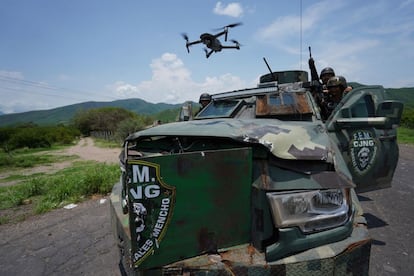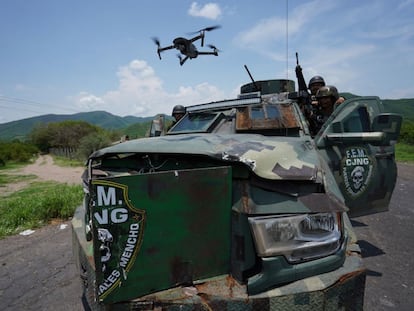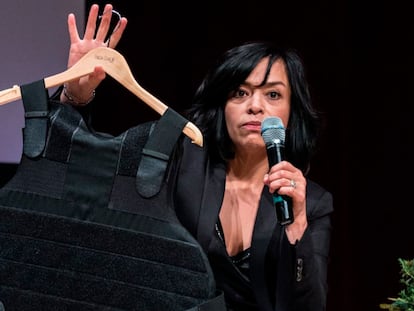Drones: The latest weapon (and status symbol) of Mexico’s cartels
According to experts, criminal organizations in Michoacán are using unmanned aerial vehicles to drop bombs, transport drugs and intimidate the public


Cartel members may belong to a criminal organization, but most of them are still teenagers and youngsters without a lot to do. They’re big kids living in rural areas such as the Mexican state of Michoacán, where each day is more or less the same. The monotony is broken by sudden moments of violence and adrenaline. These members will likely be dead within five years, killed either in a shootout with police or by a rival gang. But apart from this sporadic violence, life is fairly routine and dull – nothing like the narcocorridos, which sing of excitement and glory, or Netflix’s Narcos series, where it is all about glamor. These youngsters get bored – just like any young person in a small town anywhere in the world, says Romain Le Cour, a doctor in Political Science at the University of Paris, who is carrying out an in-depth investigation into violence in Michoacán. The difference is, unlike other youngsters, they have access to weapons. And to kill their boredom, uphold their status and make clear who is in control, they use them. Their latest toy is the drone.
“You have to imagine a context in which young men between the ages of 15 and 30, men from ranches, rural areas, get bored in their job as a hitman, smoke pot, use drugs, drink alcohol… 95% of the time, nothing happens, there is a masculine boredom that is very universal,” says Le Cour. “The drone becomes a fun tool. It’s fun and then there is everything else.” According to experts, the main practical use of drones is surveillance – it is used to monitor the movements of police and rivals, observe remote or difficult to access areas such as woods and mountains and it is difficult to shoot down. Cartels also use drones to transport small amounts of drugs, and on one-off occasions, to launch attacks.
In mid-January, a video recorded on a drone controlled by the Jalisco New Generation Cartel (CJNG in its Spanish acronym) went viral. In the footage, the drone is seen to drop several bombs on Tepalcatepec, a municipality in Michoacán that has been hard hit by narco-violence. For the past few years, these types of attacks have now been happening in the state every few months. It’s a worrying trend, says Le Cour, who has been spending time with youngsters in prison as part of his research. “There is a change in panorama, but the big question is: what does all this serve? I think strategically, if you compare it with the levels of violence in Michoacán, it’s one more tool in the spectrum, which ranges from murder and forced disappearances to torture and extortion.”
In 2021, Michoacán was the Mexican state with the third-highest number of murders, recording 2,732 homicides, according to the Security and Civil Protection Secretary. For years, rival cartels – such as CJNG, Cárteles Unidos and what’s left of La Familia Michoacana and Caballeros Templarios – have been battling for control of the state, while local self-defense groups have also become involved in the fight. “Drones killed maybe five people in Michoacán in the last year, at the most. I don’t deny that the use of drones is worrying, but if we compare it to the thousands of people who die in the state, in terms of violence, the impact is still limited,” says Le Cour.
Cecilia Farfán Méndez, head of security at the Center of Mexico-US Studies at California University in San Diego, who is an expert in violence, agrees. “While it’s possible that we will see more drones in the future, I don’t think it will be an important part of how [the cartels] operate. What I think is interesting is that they are broadcasting this, that they released the video [of the drone footage]. The intention is for it to be seen. It’s very glamorous and scandalous to have a video from a drone. But whether this has important implications with respect to what we see in the future is not so clear.”
“What is worrying is that now we have hard data that shows that the population thinks organized crime groups have more firepower than the Mexican armed forces, and this is wrong,” she adds. Indeed, the drones used by the cartels are not drones designed for combat, but rather commercial products that anyone with enough money can buy online for a few hundred dollars. From there, it is not difficult to turn the drone into a weapon. A hook that can be controlled remotely from a cellphone is added to the drone, and then a bomb is placed on it. A plastic cup is stuck to the bomb with duct tape, which acts as a kind of parachute and gives it the appearance of a badminton shuttlecock. Once the drone is over the target, the bomb is released.
#Michoacan - Drones. 2021, Tierra Caliente
— Romain Le Cour (@romainlecour) January 12, 2022
Me mostraban drones modificados y cargas explosivas. Hay pilotos "instructores". El dron es arma, herramienta táctica (pero tmb juego, moda, chiste)
Hay carrera armamentista. Drones son parte de ella. Desafío: atenderla como tal #armas pic.twitter.com/oBIROPyOHs
“They showed me modified drones and explosive charges. There are ‘teaching’ pilots. A drone is a weapon, tactical tool (but also game, fashion, toy). There is an arms race. Drones are part of it. The challenge: to treat them like weapons.”
The drone used to bomb Tepalcatepec falls into this category of commercial devices. Even the explosives used were homemade. “It appeared to be C-4 [a common variety of plastic explosive] from the size of the explosion, but it is not difficult to make homemade explosives if you have access to chemicals in a drug laboratory,” says Daniel Gómez-Tagle, an analyst on police and military equipment. “It’s important to point out that not just anybody could make them. Knowing the formula is not the same as knowing how to make them, they are not uneducated hitmen. These are people who understand physics and chemistry at least on an intermediate level. These are devices that have been made increasingly more sophisticated over the years, either from testing or specialized design.”
The use of drones has been most documented in Michoacán, but criminal groups across Mexico have also begun to use the devices. Le Cour says that teachers are even hired to teach young gang members how to use unmanned aerial vehicles.
Status symbol
“The use of drones is absolutely an element of power and status,” says Chris Dalby, the managing editor of InSight Crime, an investigative website focused on organized crime. “It’s a very strong symbol that you have money, and there is a lot of money in Michoacán.”
He adds: “The Jalisco Cartel has a very good understanding of the effectiveness of marketing. [Drones] are a very ineffective way of killing compared to conventional firearms and explosives. [...] However, for the people who were in Tepalcatepec, being bombed from the air was very traumatic. Locally, in the areas they are used, they can be a very effective weapon of intimidation.”
In broader society, drones have also become more fashionable. Between 2016 and 2019, the number of unmanned aerial vehicles registered in Mexico shot up 2,000%, according to the statistics website Statista. And this figure is expected to multiply. “It’s something fun, lots of people use it even in rural contexts because it is a tool that allows you to monitor your ranch, to supervise building works,” explains Le Cour. And narcos have not escaped this trend. “Drones have become part of the fashion in arms trafficking. Fifteen years ago, it was to look like a rancher. Now the fashion among groups, at least in Michoacán, is to look like the special forces, a look the Zetas introduced in their time: boots, high-caliber firearms, kevlar [bullet-proof vests], uniforms…”
For Mexico’s narcos, drones have become a tool with many uses. As well as being a strategic, tactical and military tool, it also serves as propaganda and marketing, as seen in the attack on Tepalcatepec. “I can honestly understand that dropping a bomb with a drone, filming it and sharing [the footage] could be like something from a video game. It’s very attractive and sexy in terms of propaganda. Not only does it allow you to send a message to an enemy group; if you made the video, you’re the cool guy. And that is valued a lot.”
Tu suscripción se está usando en otro dispositivo
¿Quieres añadir otro usuario a tu suscripción?
Si continúas leyendo en este dispositivo, no se podrá leer en el otro.
FlechaTu suscripción se está usando en otro dispositivo y solo puedes acceder a EL PAÍS desde un dispositivo a la vez.
Si quieres compartir tu cuenta, cambia tu suscripción a la modalidad Premium, así podrás añadir otro usuario. Cada uno accederá con su propia cuenta de email, lo que os permitirá personalizar vuestra experiencia en EL PAÍS.
¿Tienes una suscripción de empresa? Accede aquí para contratar más cuentas.
En el caso de no saber quién está usando tu cuenta, te recomendamos cambiar tu contraseña aquí.
Si decides continuar compartiendo tu cuenta, este mensaje se mostrará en tu dispositivo y en el de la otra persona que está usando tu cuenta de forma indefinida, afectando a tu experiencia de lectura. Puedes consultar aquí los términos y condiciones de la suscripción digital.
More information
Archived In
Últimas noticias
There is as much life left to discover on planet Earth as that which is already known
Dozens presumed dead, around 100 injured in fire at Swiss Alps bar during New Year’s celebration
Is porn for women different from conventional porn? We spoke to those who make it
Cartagena de Indias is sinking: What can the city do to mitigate it?
Most viewed
- Reinhard Genzel, Nobel laureate in physics: ‘One-minute videos will never give you the truth’
- David King, chemist: ‘There are scientists studying how to cool the planet; nobody should stop these experiments from happening’
- Oona Chaplin: ‘I told James Cameron that I was living in a treehouse and starting a permaculture project with a friend’
- Sinaloa Cartel war is taking its toll on Los Chapitos
- The Interoceanic Train, the Mexican alternative to the Panama Canal










































